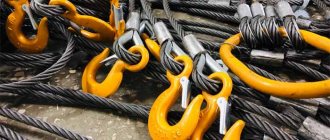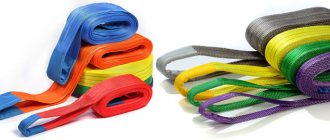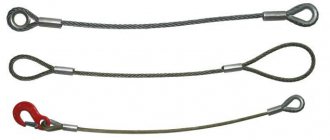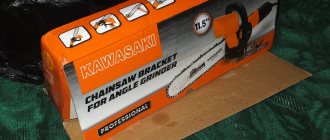For the safety of lifting and loading and unloading operations, slings, connecting elements, grips, blocks and other devices must undergo regular inspection. The rules and procedures for conducting inspections are developed either by a specialized organization or by qualified engineering and technical personnel in accordance with state recommendations on labor protection. To do this, first of all, an inspection log is compiled, where the results for each individual device are recorded. Based on the results of the inspection, a decision is made on whether the device can be accepted for further work or not.
How to inspect slings?
It is recommended that the slings be inspected by a qualified technician at least every 10 days. The timing of the inspection should primarily depend on the intensity of their use. If slings are rarely used, inspection can be carried out immediately before use. If they are used frequently and under heavy load, inspection should be carried out regularly.
The rules for inspecting slings made of different materials have both common elements and some differences due to their characteristics. Rope slings undergo 3 stages of testing:
- outer;
- instrumental;
- interior.
Chain and textile slings pass only the external and instrumental stages. As a result of the inspection, if the identified defects and damage do not comply with the sling rejection standards, then the slings should not be allowed to work. We described in detail the standards for rejecting rope, chain and textile slings in a separate article. Let's look at the procedure and rules for inspecting them separately.
Equipment used for testing
The list of equipment on which it is necessary to monitor the condition of slings is listed in the norms of Russian legislation. If the procedure is ignored, administrative liability is provided.
Regular inspection of slings increases the level of safety of cargo and hired personnel. Inspection must be carried out within a clearly defined time frame for inspecting the slings. High-quality maintenance is necessary for such devices that check the reliability of the slings. The safety rope or lanyard may break, causing significant damage to the work site. For this reason, many managers do not skimp on properly maintaining verification systems.
Inspection of rope slings
During the external inspection of rope slings, the compliance of the sling with the passport data, the condition of the rope, loops, branches, connecting elements and grips are examined.
Important!
For the safety of the sling, high-quality sealing of the free end of the rope after creating the loop is important. The radius of the loop must be at least 2.5d, and the tail of the rope must be at least 2d (d-diameter of the rope).
During an external inspection along the length of the rope, defects and damage are examined either with the naked eye or with a 10x magnification magnifying glass.
Next, during the instrumental stage, measurements of the diameter of all existing defects are made:
- reducing the diameter of the rope;
- the amount of corrosion or other wear;
- degree of waviness;
- length of rope branches and their difference, etc.
A caliper, metal ruler, tape measure and micrometer are used to measure defects and damage.
Internal inspection of the rope is carried out selectively to assess the condition of the internal strands and core. To do this, two clamps are used, with one of which the rope is fixed, and with the help of the other it is turned in the opposite direction with the lay. As a result, the outer strands move away from the core. Next, the strands and core are inspected. It is necessary to pay attention to the degree of corrosion, wear of the strands and core, rupture and reduction in area. After carrying out the work, you need to lubricate the inspected section of the rope both inside and outside. It is recommended to carry out an internal inspection of the following sections of the rope: places of contact with blocks, near the termination, with corrosion and damage to the outer wires, with thermal damage.
General information
1.1.
Removable load-handling devices and containers are used in the process of lifting and moving goods using lifting structures. Slinging, tying and hooking of solid loads for lifting, moving and lowering them when performing construction, installation, loading and unloading and other work using lifting structures is carried out using removable load-handling devices. Moving small-piece cargo is allowed only in special containers designed for this purpose in order to exclude the possibility of individual parts of the cargo falling out. Bricks are moved on pallets without fencing only when unloading (loading) vehicles onto the ground (and from the ground), unless otherwise specified in the operating manual (instructions) and other operational documents for the container or in the PPR. To lift and move liquid and bulk cargo, special containers are used (tubs, trays, boxes, containers, buckets, etc.).
1.2. Depending on the conditions of work, the geometric dimensions and weight of the load, lifting devices of different designs are used (slings, traverses, grips, etc.). Slings are among the simplest lifting devices in design and are flexible elements with end fastenings and gripping elements of various designs. As a rule, steel wire ropes, less often chains and tapes, are used as a flexible load-bearing element.
1.3. Steel ropes have a high specific load-bearing capacity and flexibility, are much easier to work with and more durable than ropes made from organic plant fibers or steel load chains. A steel wire rope smoothes out dynamic loads and is reliable, since the destruction of the rope does not occur suddenly, like a chain, but the number of broken wires increases gradually, which allows you to monitor the condition of the rope and reject it long before the break.
1.4. The advantages of steel chains compared to steel ropes are their high flexibility, simplicity of design, manufacturability and ability to bend around sharp edges without the use of pads. Significant disadvantages of steel chains are their large mass, the possibility of sudden rupture due to the rapid opening of formed cracks and the need for careful daily monitoring of the condition (wear) of chain links. In addition, steel chains do not allow the application of dynamic loads, and defects in the metal of the chain links are difficult to detect.
1.5. According to the number of branches, slings are divided into single-branch rope (1SC), two-branch (2SC), three-branch (3SC), four-branch (4SC) and universal (USK), single-branch chain (1SC), two-branch (2SC), three-branch (3SC), four-branch ( 4SC) and universal (USC). Simple slings (SK and STs) are used for hanging loads that have special devices (loops, hooks, eyes, bolts, etc.), universal slings are used for slinging loads with a harness. A single-leg sling with a hook or other load-grasping device is usually used to grab and move loads equipped with mounting loops or eyes, brackets, etc.
1.6. Multi-leg slings are used for lifting and moving building parts and structures that have two, three or four attachment points. They are widely used for slinging building elements (panels, blocks, trusses, etc.) equipped with loops or eyes. When using a multi-leg sling, the load must be transferred to all branches evenly, which is ensured by auxiliary connections.
1.7. Universal slings are used when lifting loads that cannot be tied with ordinary slings (pipes, boards, rolled metal, apparatus, etc.).
1.8. Traverses are used for lifting and moving long or large-sized structures or equipment (columns, trusses, beams, apparatus, pipes, etc.). Crossbars are designed to withstand compressive or tensile forces. They protect the load from the compressive forces that occur when the load is tilted and ensure safety when it is moved by a crane. Traverses are hung on the crane hook using a gusset with an eye (ring) or flexible or rigid rods that are hinged, which completely frees them from bending moments. Hanging traverses on a crane hook using rigid and flexible rods leads to loss of useful lifting height. Rope slings at the free end end with hooks of various designs that interact with product staples or pin locks mounted on a traverse with thimbles inserted into the sockets of the lock body. The pin is pulled out manually by the rope attached to it (remote control).
1.9. Grips are the most advanced and safe load-handling devices, the main advantage of which is the reduction of manual labor costs when grabbing a load and placing it in the designed position by a crane. It is advisable to use grippers in cases where it is necessary to move structures of the same type. With grips installed on the slings, you can quickly secure the sling to the rails, channels and beams being lifted. Using connecting links and rigging shackles, the grippers are quickly secured to the slings. The slings can also be used to attach hooks, sheet clamps, and other accessories.
1.10. The most common types of steel technological containers for lifting and moving piece, packaged, semi-liquid and liquid cargo, as well as cargo classified as explosive and fire hazardous, are boxes, tubs, containers, bunkers, containers, pallets and other packaging devices.
Inspection of chain slings
During a visual inspection, the presence of markings on the sling and its compliance with the passport data are checked, and the end links with connecting tools are examined. The length of the sling is also inspected for defects and damage.
At the instrumental stage, measurements are taken using a universal measuring tool. It is recommended to pay attention to the following parameters:
- diameter and length of links;
- diameter reduction;
- signs of wear and deformation;
- length of the sling, branches and their difference.
Inspection of lifting devices
It is important to regularly monitor the condition of the grips, blocks and connecting elements.
They, like slings, are subject to visual inspection and the necessary measurements. When inspecting lifting devices, you need to examine their general condition, performance, presence of defects, cracks and wear. Using a universal measuring tool, you need to check the degree of defects and compare them with the original condition. Load-handling devices are subject to rejection in the presence of cracks and tears, wear with a decrease in surface area by 10%, deformation with a change in the original size by 3%, bends, angle deviations by 3% and defects in bolted connections.
Exploitation
3.1. The specialist responsible for maintaining lifting structures in working condition is obliged to ensure that removable lifting devices and production containers are maintained in good condition (if their maintenance in good condition is not entrusted to other persons by order) by conducting periodic inspections, maintenance and repairs within the time limits established by the schedule, systematic monitoring of the correct maintenance of the inspection log and timely elimination of identified faults, as well as personal inspection of lifting devices and containers within the established time frame.
3.2. The specialist responsible for the safe performance of work using lifting structures is obliged not to allow untested, unmarked or damaged removable lifting devices and containers into work, and to provide slingers with distinctive signs.
3.3. Personnel assigned to carry out cargo hooking work, incl. in hanging lifting structures on hooks, slinging and tying loads moved by lifting structures using load-handling devices, must have a level of qualifications corresponding to the profession of slinger.
The same requirement applies to personnel of the main working professions, whose duties include hanging cargo on a hook without preliminary strapping (load that has loops, eyes, pins, located in buckets, tubs, containers or other containers), as well as in cases when the load is grabbed by semi-automatic gripping devices.
3.4. For lifting structures controlled from the floor, hooking a load onto a hook without preliminary strapping is permitted to be performed by personnel of basic working professions who have undergone testing of their skills in hooking loads and training at the workplace.
3.5. A graphic representation of slinging and hooking methods should be handed out to slingers and crane operators or posted at work sites.
3.6. Faulty load-handling devices, as well as devices that do not have tags (stamps), should not be located in the work areas. Unmarked and damaged containers are not allowed in the work areas.
3.7. Loads must be slinged in accordance with slinging diagrams. To sling a load intended for lifting, slings must be used that correspond to the weight and nature of the load being lifted, taking into account the number of branches and their angle of inclination; General purpose slings should be selected so that the angle between their branches does not exceed 90°.
3.8. The connections between the hook of the lifting machine and the suspensions, loops and thimbles of the slings must be reliable. The sling suspension must be secured with a hook latch. The mounting loop must be secured with a latch in the hook link of the sling.
3.9. In order to prevent loads from falling during lifting and moving them by lifting structures, the following slinging rules should be observed:
when tying the load, the slings must be applied without knots or twists;
Under sharp corners of metal weights (channels, angles, I-beams) it is necessary to place pads. In this case, it is necessary to take into account the location of the center of gravity of the load. The sling should be placed under the load in such a way as to prevent it from slipping while lifting the load. The load must be tied in such a way that during its movement, the fall of its individual parts is prevented and a stable position of the load is ensured during movement. To do this, slinging of long loads (poles, logs, pipes) must be done in at least two places;
The ends of the multi-leg sling that are not used for hooking must be strengthened so that when moving the load by crane, the possibility of these ends touching objects encountered along the way is excluded.
3.10. When moving a load, load-handling device or container horizontally, it should first be lifted 500 mm above equipment, building structures and other objects encountered along the way.
3.11. It is allowed to lower the transported load only to the place intended for this purpose, where the possibility of falling, tipping over or sliding of the installed load is excluded. At the place where the load is installed, pads of appropriate strength must first be laid so that the slings can be easily and without damage removed from under the load.
3.12. When carrying out work with the use of PS, lifting a load covered with earth or frozen to the ground, laid down by other loads, as well as releasing pinched slings, ropes, chains using a lifting machine is not allowed.
Inspection and accounting log
The results of inspections of slings, grips and other removable lifting equipment and devices are reflected in the inspection and accounting log. The form of the journal is approved by the owner of the devices. The following form is recommended:
| № | Designation | Name | Number | Material | Weight 1 pc. | The mass of everyone | Notes | Signature |
| 1 | GOST 7668-69 | Rope 33-IH-180 lzag 44 m | 1 | 184,8 | 185 | – |









